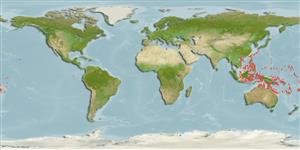Common names from other countries
>
Eupercaria/misc (Various families in series Eupercaria) >
Scaridae (Parrotfishes) > Scarinae
Etymology: Scarus: Greek, skaros = a fish described by anciente writers as a parrot fish; 1601 (Ref. 45335).
More on author: Bleeker.
Environment: milieu / climate zone / depth range / distribution range
Écologie
marin; saumâtre récifal; profondeur 1 - 25 m (Ref. 90102). Tropical; 30°N - 24°S, 107°E - 170°W
Western Pacific: Indonesia to Samoa, north to the Ryukyu Islands, south to the Great Barrier Reef. Replaced by Scarus scaber in the Indian Ocean (Ref. 37816).
Taille / Poids / Âge
Maturity: Lm ? range ? - ? cm
Max length : 40.0 cm TL mâle / non sexé; (Ref. 48636)
Description synthétique
Clés d'identification | Morphologie | Morphométrie
Épines dorsales (Total) : 9; Rayons mous dorsaux (Total) : 10; Épines anales: 3; Rayons mous anaux: 9. Males recognized by the blue snout and band behind eye. Eastern form has blue cheek and western form has yellow cheek. Females grey to yellow with dusky saddle over back (Ref. 48636). Closely resembles S. oviceps and S. scaber. In S. oviceps, the initial phase has fewer, less vertical diagonal dark bars on the back and the terminal phase lacks the light-centered bar between the eye and the pectoral fin base, is darker and less brilliant blue on the upper head and back, and is usually larger.
Inhabits coral-rich areas of clear, protected reefs (Ref. 9710). Found in lagoon and seaward reefs (Ref. 90102). Feeds mainly on algae (Ref. 26993).
Life cycle and mating behavior
Maturities | Reproduction | Spawnings | Egg(s) | Fecundities | Larves
Oviparous, distinct pairing during breeding (Ref. 205).
Parenti, P. and J.E. Randall, 2000. An annotated checklist of the species of the labroid fish families Labridae and Scaridae. Ichthyol. Bull. J.L.B. Smith Inst. Ichthyol. (68):1-97. (Ref. 35918)
Statut dans la liste rouge de l'IUCN (Ref. 130435)
CITES (Ref. 128078)
Not Evaluated
Menace pour l'homme
Harmless
Utilisations par l'homme
Pêcheries: commercial; Aquarium: Commercial
Outils
Articles particuliers
Télécharger en XML
Sources Internet
Estimates based on models
Preferred temperature (Ref.
115969): 25.2 - 29.3, mean 28.5 (based on 1649 cells).
Phylogenetic diversity index (Ref.
82804): PD
50 = 0.5000 [Uniqueness, from 0.5 = low to 2.0 = high].
Bayesian length-weight: a=0.01380 (0.00789 - 0.02416), b=3.13 (2.97 - 3.29), in cm Total Length, based on LWR estimates for this species & Genus-body shape (Ref.
93245).
Niveau trophique (Ref.
69278): 2.0 ±0.00 se; based on food items.
Résilience (Ref.
120179): Milieu, temps minimum de doublement de population : 1,4 à 4,4 années (Preliminary K or Fecundity.).
Fishing Vulnerability (Ref.
59153): Low to moderate vulnerability (30 of 100).
